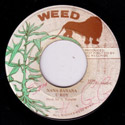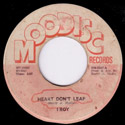DJ ALBUMS
History of DJ Music
© Steve Barrow & Peter Dalton - The Rough guide to reggae
 The early 1970s marked the beginning of the ascent of the deejay, a
trend that continued during the roots era, and went on to become
dominant throughout the dancehall and ragga phases. The story of the
Jamaican deejay record can be traced back to the ska era, when the men
who took the mike at the dances could occasionally be heard on vinyl,
shouting an introduction and/or interjecting their catchphrases. The
voice of the fabled Winston 'Count' Machuki, for instance, can be heard
on the Baba Brooks Band's steaming "Alcatraz", while Sir Lord Comic made
an impact with two massive hits that were actually credited to his name
– "Ska-ing West" and "The Great Wuga Wuga". The role of the deejay at
this point, however, was still largely confined to the dancehalls of the
day, encouraging the dancers, and promoting the sound systems on which
they were appearing. The first deejay to be recorded on more than an
occasional basis was King Stitt, longtime MC for the Sir Coxsone
Downbeat Sound System. Several of the most talented deejays who came to
notice in the early 1970s - notably Big Youth,
Dillinger, I Roy and
Prince Jazzbo continued to make fine records in the roots era, some for
their own labels. They and their numerous rivals from the next
generation no longer simply added to the excitement of the dance with
hip catchphrases: the deejay now offered commentaries on the ghetto
sufferers' tribulations, history lessons from a black perspective, and
the chanting of psalms. By the mid-1970s times were truly dread, with
Marcus Garvey and Haile Selassie as likely to be praised as the sound on
which the deejay was employed.
The early 1970s marked the beginning of the ascent of the deejay, a
trend that continued during the roots era, and went on to become
dominant throughout the dancehall and ragga phases. The story of the
Jamaican deejay record can be traced back to the ska era, when the men
who took the mike at the dances could occasionally be heard on vinyl,
shouting an introduction and/or interjecting their catchphrases. The
voice of the fabled Winston 'Count' Machuki, for instance, can be heard
on the Baba Brooks Band's steaming "Alcatraz", while Sir Lord Comic made
an impact with two massive hits that were actually credited to his name
– "Ska-ing West" and "The Great Wuga Wuga". The role of the deejay at
this point, however, was still largely confined to the dancehalls of the
day, encouraging the dancers, and promoting the sound systems on which
they were appearing. The first deejay to be recorded on more than an
occasional basis was King Stitt, longtime MC for the Sir Coxsone
Downbeat Sound System. Several of the most talented deejays who came to
notice in the early 1970s - notably Big Youth,
Dillinger, I Roy and
Prince Jazzbo continued to make fine records in the roots era, some for
their own labels. They and their numerous rivals from the next
generation no longer simply added to the excitement of the dance with
hip catchphrases: the deejay now offered commentaries on the ghetto
sufferers' tribulations, history lessons from a black perspective, and
the chanting of psalms. By the mid-1970s times were truly dread, with
Marcus Garvey and Haile Selassie as likely to be praised as the sound on
which the deejay was employed.
 Big Youth was sold to the rock audience with the strikingly packaged
Dread Locks Dread album for Prince Tony Robinson, and Virgin tried a
similar tactic with U Roy. Though the pioneering deejay had previously
avoided using his Rastafarian beliefs for self-promotion, he was
pictured on the cover of his initial Prince Tony/Virgin set with
dreadlocks and enveloped in clouds of smoke from a 'chalice'. On the
record, he chatted commercial dread lyrics over updates of rocksteady
classics. In both Big Youth's and U Roy's work for Prince Tony, the
sheer number of references to "natty dread" can be wearisome, though the
albums seem more acceptable in retrospect, and tracks from U Roy like
"Run Away Girl" and the cheeky "Chalice In the Palace" (over a recut
"Queen Majesty") showed he had retained a fair degree of wit and panache.
Big Youth was sold to the rock audience with the strikingly packaged
Dread Locks Dread album for Prince Tony Robinson, and Virgin tried a
similar tactic with U Roy. Though the pioneering deejay had previously
avoided using his Rastafarian beliefs for self-promotion, he was
pictured on the cover of his initial Prince Tony/Virgin set with
dreadlocks and enveloped in clouds of smoke from a 'chalice'. On the
record, he chatted commercial dread lyrics over updates of rocksteady
classics. In both Big Youth's and U Roy's work for Prince Tony, the
sheer number of references to "natty dread" can be wearisome, though the
albums seem more acceptable in retrospect, and tracks from U Roy like
"Run Away Girl" and the cheeky "Chalice In the Palace" (over a recut
"Queen Majesty") showed he had retained a fair degree of wit and panache.
 In this period of international exposure, U Roy also played an important
role in the Kingston dancehalls through his Stur-Gav Hi-Fi sound system,
in effect the deejay academy, with Daddy Roy as the founder of the
school. The first graduate, Ranking Joe – newly promoted from Little Joe
– deejayed the set during 1977-78 before going on with selector Jah
Screw to the champion set of the late 1970s, the reborn Ray Symbolic.
Ranking Joe was followed on Stur-Gav by Charlie Chaplin,
Josey Wales,
and Brigadier Jerry, all of whom would play influential roles in
establishing the dancehall styles of future years. U Brown was the most
notable disciple of U-Roy not to come through the Originator's sound
system. The vast majority of toasters continued to record for a variety
of producers with the rhythms and money to entice them into their
studios. Popular talkers like Dillinger, Jah Stitch,
Trinity and Jah
Woosh would occasionally release music on labels of their own, but still
found it more profitable or convenient to record for others.
In this period of international exposure, U Roy also played an important
role in the Kingston dancehalls through his Stur-Gav Hi-Fi sound system,
in effect the deejay academy, with Daddy Roy as the founder of the
school. The first graduate, Ranking Joe – newly promoted from Little Joe
– deejayed the set during 1977-78 before going on with selector Jah
Screw to the champion set of the late 1970s, the reborn Ray Symbolic.
Ranking Joe was followed on Stur-Gav by Charlie Chaplin,
Josey Wales,
and Brigadier Jerry, all of whom would play influential roles in
establishing the dancehall styles of future years. U Brown was the most
notable disciple of U-Roy not to come through the Originator's sound
system. The vast majority of toasters continued to record for a variety
of producers with the rhythms and money to entice them into their
studios. Popular talkers like Dillinger, Jah Stitch,
Trinity and Jah
Woosh would occasionally release music on labels of their own, but still
found it more profitable or convenient to record for others.
 The 80s decade was first and foremost about deejays. This plethora of
chatters was presaged at the close of the preceding decade, when a
handful of deejay versions were released before the corresponding
vocals. Junjo's Volcano label had hits with practically every deejay
who meant anything in the dancehalls of the day. The first rank of these
included the Stur-Gav stars Josey Wales. and Charlie Chaplin, both of
whom had obviously learned much of their craft from U Roy, but skilfully
applied the older man's tuition to Junjo's modern rhythms. Ranking
Toyan, a slightly asthmatic-sounding deejay from the Socialist Roots and
Romantic Hi-Fi sound systems, was another highly rated live performer
who only sometimes lived up to his dancehall reputation on record;
Junjo, along with Don Mais (his first producer), caught him at very near
his best, most notably on the How the West Was Won album, which made a
considerable impact in London, partly thanks to the attractive packaging
given it by Greensleeves. The same UK company served future producer
Captain Sinbad just as well with a similarly eye-catching cover, and
Junjo's pairing of Trinity's younger brother Clint Eastwood (b. Robert
Brammer) with the UK deejay General Saint (Winston Hislop) even reached
the lower regions of the British pop charts. But when it came to sales,
nothing could quite match the alchemy between the fastest-rising
producer and the most popular chatter of the era, Yellowman.
The 80s decade was first and foremost about deejays. This plethora of
chatters was presaged at the close of the preceding decade, when a
handful of deejay versions were released before the corresponding
vocals. Junjo's Volcano label had hits with practically every deejay
who meant anything in the dancehalls of the day. The first rank of these
included the Stur-Gav stars Josey Wales. and Charlie Chaplin, both of
whom had obviously learned much of their craft from U Roy, but skilfully
applied the older man's tuition to Junjo's modern rhythms. Ranking
Toyan, a slightly asthmatic-sounding deejay from the Socialist Roots and
Romantic Hi-Fi sound systems, was another highly rated live performer
who only sometimes lived up to his dancehall reputation on record;
Junjo, along with Don Mais (his first producer), caught him at very near
his best, most notably on the How the West Was Won album, which made a
considerable impact in London, partly thanks to the attractive packaging
given it by Greensleeves. The same UK company served future producer
Captain Sinbad just as well with a similarly eye-catching cover, and
Junjo's pairing of Trinity's younger brother Clint Eastwood (b. Robert
Brammer) with the UK deejay General Saint (Winston Hislop) even reached
the lower regions of the British pop charts. But when it came to sales,
nothing could quite match the alchemy between the fastest-rising
producer and the most popular chatter of the era, Yellowman.





